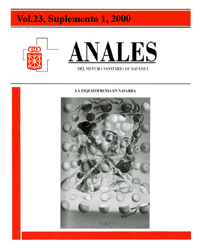Evolution of treatment patterns of schizophrenic patients
Keywords:
Esquizofrenia. Tratamiento. Neurolépticos convencionales. Neurolépticos atípicos.Abstract
At present, psychopharmacology, and more specifically the neuroleptics, form the basic pillar on which the treatment of schizophrenia rests. Until a few years ago, this type of medicine had the drawback of provoking frequent and disturbing secondary effects, besides not acting on the so-called negative symptoms of the disease. The recent appearance of several atypical neuroleptics, thus known because of their different mechanism of action at the level of the cerebral receptors, has given rise to hope with respect to the treatment of schizophrenic patients; this is due to the low secondary effects that they produce and to their possible action on the negative symptoms. This paper analyses the evolution in the pattern of treatment of schizophrenic patients, in the light of the appearance of these medicines, on a sample of patients whose illness began when only one of these atypical neuroleptics was available commercially, although its use was restricted. In the light of those results, we conclude that the atypical neuroleptics are becoming established in the treatment of schizophrenia, although they have not so far displaced conventional neuroleptics. On the other hand, our data suggest that new studies are needed aimed at optimising the choice of a suitable neuroleptic for each patient, as well as the development of measures directed at rehabilitating these patients for work.Downloads
Downloads
Published
How to Cite
Issue
Section
License
La revista Anales del Sistema Sanitario de Navarra es publicada por el Departamento de Salud del Gobierno de Navarra (España), quien conserva los derechos patrimoniales (copyright ) sobre el artículo publicado y favorece y permite la difusión del mismo bajo licencia Creative Commons Reconocimiento-CompartirIgual 4.0 Internacional (CC BY-SA 4.0). Esta licencia permite copiar, usar, difundir, transmitir y exponer públicamente el artículo, siempre que siempre que se cite la autoría y la publicación inicial en Anales del Sistema Sanitario de Navarra, y se distinga la existencia de esta licencia de uso.








